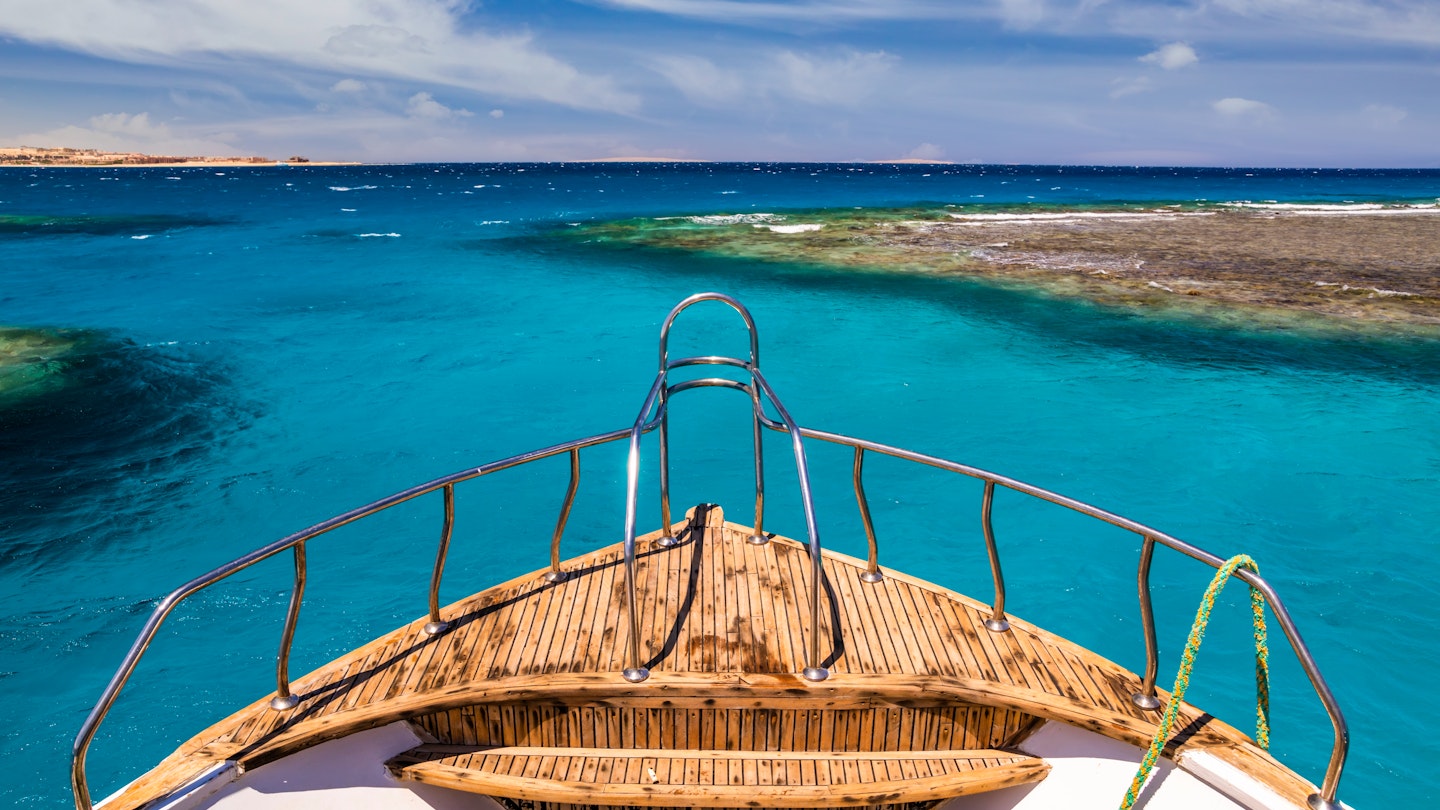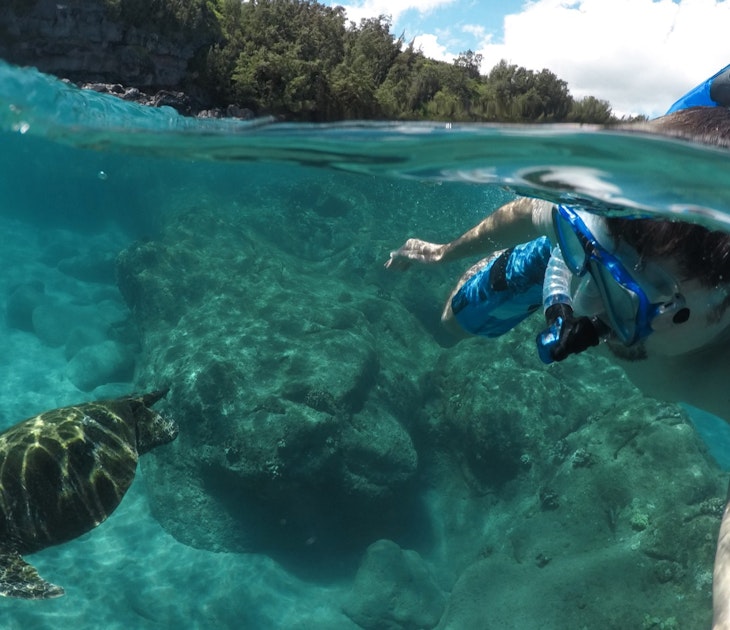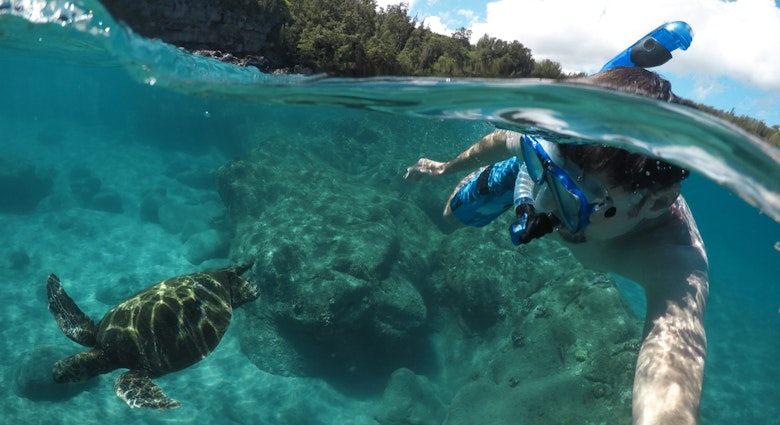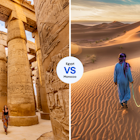These days Egypt's Red Sea Coast is mostly known for its sun-and-sea family holidays but this world-class diving destination is more than beach sloth resort life. This famed shoreline is the access point to the wild and remote landscapes of the Eastern Desert’s raw expanse while delving below the sea’s surface is the fantasia of reefs that put the Red Sea Coast on the tourism map in the first place.
Easy diving day trips
For first-time divers or travelers who just want to add a diving day into their resort holiday, the dive sites of the Giftun Islands and the Straits of Gubal are easy day-trip options from Hurghada or El Gouna.
Spot outcrops of brain coral, with their cerebral-like grooves, while diving the horseshoe curved reef of Sha’ab Al Erg in the Straits of Gubal. Keep your fingers crossed and you may be lucky enough to see a bottlenose dolphin – they’re regular visitors here.
For abundant sea-life spotting head further north in the Straits to the sites around Siyul Island. Leopard sharks, turtles, glassfish and moray eels are commonly spotted while diving Siyul Kebira.
Gota Abu Ramada’s oval reef is one of the most popular Giftun Islands dive sites with parrotfish, triggerfish and butterflyfish all darting between candyfloss puffs of soft corals. For drift dives, you can’t beat Small Giftun Island where hawkfish flit through forests of spiny branched gorgonian fans on the reef.

Diving the Straits of Gubal wrecks
One name towers above all when it comes to Red Sea wreck diving. The Thistlegorm is renowned as one of the world’s top five wreck dives. German bombers targeted the ship in 1941, consigning it, and its booty of supplies meant for the Allies’ North Africa campaign, to the deep.
Today, exploring the seabed scattered with Bren gun carriers, motorbikes, Bedford trucks and tanks which never made it to the front is like wandering through a WWII time capsule.
For time-strapped divers trying to fit some Red Sea wreck diving into a Nile Valley temple and tombs itinerary, the bonus of diving the Thistlegorm from the Red Sea coast rather than from Sharm El-Sheikh in the Sinai is that some El Gouna and Hurghada dive operators sell it as a (long) day-trip rather than solely as part of a liveaboard (divers living on the ship) trip.
Another day-trip wreck diving option is Sha’ab Abu Nuhas with four recreational dive wrecks. Two of the best are the Carnatic, a steamship that ran aground on the reef in 1869, and the Giannis D, a freighter that struck the reef in 1983 and now lies in three pieces on the seabed.

Explore the Brothers Islands
Accessible only by liveaboard (the islands are an eight-hour boat trip from Hurghada), the Brothers Islands present some of Egypt’s best far-from-the-crowds diving. Here divers can explore the Numidia, a cargo ship encrusted in soft corals, which hit the reef in 1901 and is now home to barracuda and trevally.
Wall dives just off Little Brother Island showcase vibrant rainbows of soft and hard corals and the chance of encounters with silvertip reef sharks as well as occasional hammerheads.
Deep south diving
For dive aficionados, Marsa Alam on the Red Sea Coast has long been Egypt’s in-the-know destination. The past few years have seen plenty of development along the shoreline here, opening up the area to beach holiday tourists, dabbling with a few recreational dives, as well as hard-core diving enthusiasts.
Just a 20-minute trip from shore is the famous Elphinstone Reef where technicolor shoals of anthias zip past sheer walls engulfed in gorgonian fans and spinous trees of black corals.
Heading out on a liveaboard from Marsa Alam (or from Hurghada and El Gouna) though allows you access to the remote dive sites of the deep south where the best of the Red Sea’s big pelagic action is on show.
Dive Daedalus in April or May for your best chance of spotting a manta ray or whale shark. The dive sites of the Fury Shoals and St John’s Reefs are eerie wonderlands of vast coral canyons, tunnels and caves where reef sharks patrol the deeper depths.

Organizing a dive
Many of the big resorts have a dive operator on site. The quality and cost of dive trips vary hugely between operators so do your homework before simply booking with the resort’s operator. Many of the more reputable dive companies will provide transfers from other hotels.
With bases both in El Gouna and Marsa Alam, Emperor Divers runs a range of dive day-trips and multiday liveaboard itineraries. They’re also a one-stop-shop for PADI courses from Open Water certification for beginners to specialty diving training.
In Hurghada, both Dive Hurghada and Simsim Dive offer dive excursions catering for complete novices to experienced divers as well as liveaboard options.
Kitesurfing on the Red Sea
Though diving is a major draw on a trip to the Red Sea, there are plenty of activities that take place above rather than under the water. Kitesurfing is big year-round in both El Gouna and Safaga thanks to great wind conditions and a gently shelving shoreline.

While both destinations can cater to all levels of kitesurfing experience from first-timers through to advanced, El Gouna’s resort caboodle of restaurants, entertainment and other activities make it a better bet if you simply want to add some water sports into your holiday rather than base your trip around it.
In El Gouna, both Red Sea Zone and KBC have a full range of kitesurfing courses and holidays ranging from one-day beginner lessons to multiday kite-safari trips.
For wakeboarding, El Gouna’s mammoth Sliders Cable Park is one of the biggest in the world, making this resort the Red Sea choice for wakeboarders. Meanwhile, Safaga is where in-the-know windsurfers head for Egypt’s best windsurfing conditions.
Exploring the Eastern Desert
Sunrise or sunset desert excursions by jeep, ATV, horse or bike allow you to dip your toe into the rugged landscapes inland from the coast. Resorts and hotels of El Gouna, Hurghada and Marsa Alam will easily arrange the trips, but there are better ways to experience one of Egypt’s lesser-seen regions.
Opened in 2019, the Red Sea Mountain Trail is a 170km (106mi) circuit traversing the Eastern Desert’s jagged mountain core. All of the trail’s trekking activities are organized and run by the Red Sea coast’s local Maaza Bedouin tribe who also act as guides and provide full support for hikers.
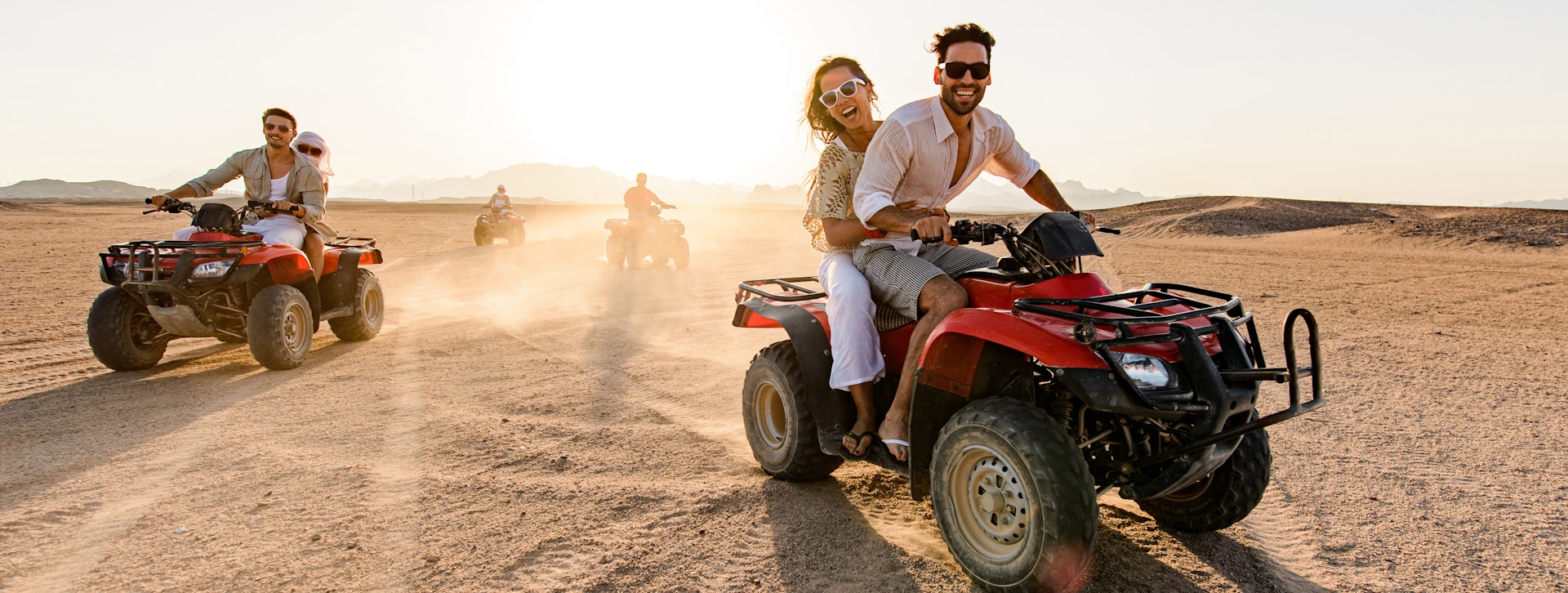
The trail offers plenty of day-hike options ranging from moderate rambles across wadis (valleys) and mountain passes to ancient Roman granite quarrying sites, to serious mountain ascents, all within a 1.5-hour drive of Hurghada.
Hiking fees include transfers, permits, guide, lunch and water. Thru-hikes of the entire trail look likely to be available from 2022.
Further south in the Eastern Desert, easiest accessed from Marsa Alam, is the brutal, remote scenery of the Wadi Gimal Protectorate. Amid its raw windswept wadis and craggy peaks, the Romans mined for emeralds and left a handful of ruins upon the desert ridges.
The main Roman settlement of Sikait and the mines of Nugrus, where pottery fragments crunch underfoot as you walk on the sand, are fascinating reminders of the era when Egypt’s emeralds helped fund the might of the Roman Empire.

Visiting the Eastern Desert’s Coptic monasteries
With all the sun-and-sea on the doorstep, it’s easy to forget that the Red Sea region is home to plenty of history as well. If you can pull yourself off the beach the remote Coptic monasteries of St Anthony and St Paul in the northern Eastern Desert are a worthy contrast to the sand.
Hidden behind formidable walls, amid craggy cliffs, they mark the birthplace of Christianity’s monastic traditions and are still major places of pilgrimage for Coptic Egyptians.
Both complexes date back to the 4th century CE and house churches, palm-shaded gardens and mudbrick monk cells. For art lovers, the Monastery of St Anthony, in particular, is a must. The Church of St Anthony (part of the monastery) is home to one of the most important collections of Coptic art in Egypt.
Hotels and travel agencies in Hurghada and El Gouna can all organize day-trip excursions visiting both monasteries.
Best times to go to the Red Sea Coast
Diving is year-round but peak season is March to June and October to November. Spring and autumn are also the best seasons for Eastern Desert excursions. Dive conditions during the summer months of July to September are brilliant but back on land many will find the weather too hot for comfort.
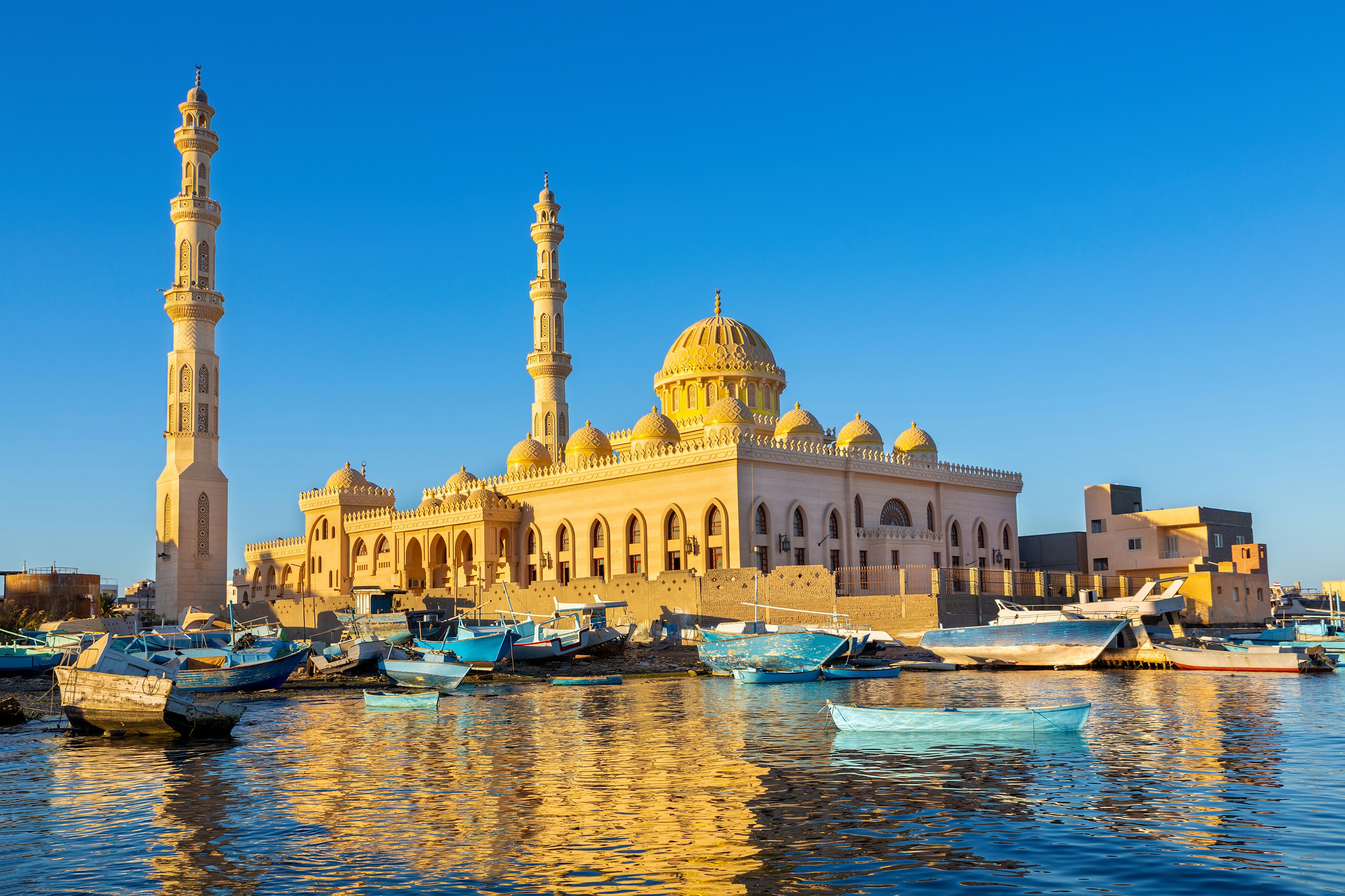
During the months of December through to February, the Red Sea resorts become a winter sun holiday-haven for northern Europeans. Particularly in January and February, winds are strong and sea conditions can be rough so first-time divers should opt for spring or autumn diving rather than winter.
Hurghada is the Red Sea’s main transport hub. With regular bus connections to Luxor (4.5 hours inland) it’s simple to combine a few days diving with a Nile Valley trip.
Hurghada Airport has several daily services to Cairo with EgyptAir as well as direct flights to Europe with several budget airlines. El Gouna is about 30 minutes from the airport by taxi. Marsa Alam also has an airport which is served by two flights weekly with EgyptAir from Cairo and a couple of European low-cost airlines.
Egypt is on our 2022 Best of Travel list. For more stories from some of the world’s most exciting destinations click here.
Safety recommendations and restrictions during a pandemic can change rapidly. Lonely Planet recommends that travelers always check with local authorities for up-to-date guidance before traveling during Covid-19.
You might also like:
Where to find the best scuba diving sites in the Middle East
Tapping into Egypt's gentler pulse in Aswan
Egypt's best foods and where to find them
